
This is still a work in progress, and though there are more than 2,800 words here and 50 photos already, I assure you that more of both are coming. There are likely big mistakes dwelling in this post as I haven’t passed anything through Caroline yet, but over the coming week or so, those things will all be made as close to perfect as we can get them. This first part of the post is now dated but I’m deciding to leave it as a reminder of my process and a hint at the occasional urgency I tried working through when we are out on busy days.
The sign says Chamula, but we’re going to another Mayan municipality first, Zinacantán. As for the direction towards Tuxtla Gutierrez, we still have a few days before we take that road on our way home, but now is not the time to think about that.

At the edge of Zinacantán, we are greeted by this sign demanding that everyone here for tourism stop to pay an entry fee. While we were on our way out here, we learned that many of these smaller villages are unaccustomed to visitors and are still trying to reconcile the need for tourism dollars with a bunch of foreigners coming in to gawk at people going about their normal lives. Then there’s the issue of cultural appropriation, where business people from the outside see an opportunity to grab motifs, clothes, and stories to profit from them after they leave these remote corners.

We are being taught that particular villages specialize not only in unique clothing that reflects their locality but also in what they grow and raise on their lands. In the case of Zinacantán, the specialty across the hillsides is flowers. Not only are the hillsides covered with greenhouses, but flowers also adorn women’s skirts, shawls, blouses, bags, and rebozos (the slings in which they carry babies). Men’s formal wear also includes vests or ponchos embroidered with floral motifs. Regarding this photo, we’ve already been told that we’ll most likely be turned down if we ask to take someone’s portrait and that we should focus on something in the general direction and not make it obvious that we are trying to take an individual’s image.
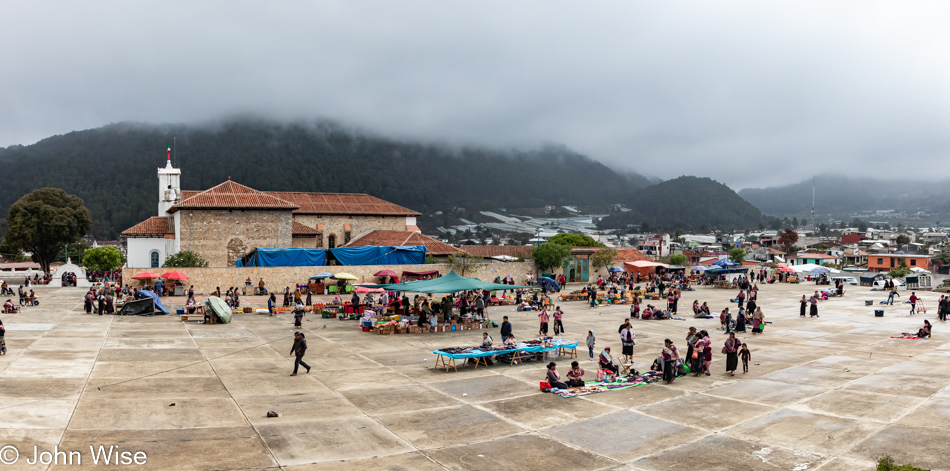
It’s Sunday here, market day. By the way, Zinacantán means “Land of the Bats” in Nahuatl (not the local language; folks here speak Tzotzil). The bat is a symbol for merchants, and since the dawn of time, Zinacantecans have traded with neighboring peoples such as the Aztecs, historically with salt but also cacao and (post-conquest) coffee.

We’re not here only to check out textiles; we’ll also be visiting a couple of churches. It’ll take a while before we can enter the church of San Lorenzo (patron saint of Zinacantán) while the men are crowded around the entry for a meeting that had been called by the municipality. Inside, it appears that mass is being held.

I don’t know if I pointed this out earlier, but it would bear repeating even if I had: very rarely have we heard a child whining or crying. Many times we see girls as young as 7 or 8 carrying their baby brother or sister with all the bearing of a parent. Then there are the dogs, the most chill non-barking dogs anywhere. After making this observation to another guest or two, they assured me that this wasn’t the case in all places across Mexico and Guatemala, some of which a few of our fellow travelers call home.

For many women across the region, their livelihood depends on their weaving, spinning, and needlepoint skills. When driving through the mountains, we’ll see women working steep farms, butchering meat, selling veggies, or sitting outside with a backstrap loom attached to their waist, weaving some of the things you see here. Most of the embroidery you see here is done with old treadle sewing machines, but that isn’t meant to take away from the high level of artistry employed.

Clearly, the works of the women of the Zinacantán village are popular with our fellow travelers.

This smiling woman was eager to teach the ladies how to wear and tie the shawls while also expecting some small tip. Regarding tips and the costs of things here, we often wince when we first read prices when a sticker has $1,200 written on it. But once we do the math, that’s only $60 in U.S. dollars, and so it is with tips. When you throw someone $40 pesos, you are giving them U.S. $2.00. The thing is that here in the poorest state of Mexico, an extra $20 pesos or $1 can go far when you make less than $2,000 a year.

Done with shopping, it was time to dip into the small church of San Sebastian as we waited for the men to finish their meeting in front of the San Lorenzo church pictured above. After making our donations, we were given permission to take photos of anything we wanted. I jumped over to the three men playing music and the five others who were singing and dancing; maybe it’s more like stomping and swaying. It turned out that they were here performing a ritual as one of the men had brought salt from the lowlands as a donation to the community.

As I said above, Zinacantán is the place of flowers, and that theme will be seen throughout the village.

Looking at this photo and the similar one above, I’m thinking I should get rid of one of them but can’t decide which, so they both stay.

Symbolism and the mixing of religions blur the lines of, what is what, in this land of the Maya. There are not only the hats, banners, dark and clear soda, fruit, men’s bags, and weavings there are other parts that follow a protocol known to the adherents in attendance here, but even my best guess regarding their significance would likely miss the mark.

Jaguars are certainly integral to the Mayan worldview, but I’m uncertain how they fit the Catholic doctrine. I point out this equation as it’s been discussed how traditional Maya culture was worked into Catholicism, where there were elements of similarity that left the indigenous people of these lands seeing parallels, thus making the swallowing of outsider customs more palatable.

Saints and crosses are numerous, but if you look closely, the cross is actually the old Mayan cross.

The music is simple, and the words the men chant in the Tzotzil language are unintelligible to my ears, but the beauty is universal. What I didn’t mention yet is that we are offered pox (pronounced posh), strong alcohol distilled from corn and sugar cane, in a communal cup that we pass around. Pox, a ceremonial drink, is a specialty of the neighboring municipality of Chamula.

I’m struck that all of this pomp and circumstance is about someone bringing a bag of salt to the community. To elevate this essential staple of our diets to this status may be peculiar to us, but that might be because we no longer own any ceremonies of deep appreciation or offering sincere thanks unless you consider extravagance and consumerism to fit that idea. Thinking about this another second, I should stipulate that this community is giving thanks in a church to a mineral celebrating a required element that sustains life, not showing off a mutant turkey or parading a couple of thousands of dollars of gifts squirreled away below a tree destined for the trash bin.

We entered the church of San Lorenzo, and after checking with a local official, I was granted permission to snap a few photos. Note that the decorative bands overhead also feature beautiful embroidered flowers.

As the mass is nearing its end, a baptism ceremony is about to begin in a side chapel.

We are little prepared for the contrast of cultural images we will witness today. Here, a lady bows before the patron saint of the area while merged into the entire process are the flowers that define a large part of their cultural identity. The baptism is obviously Christian but I think we can only guess what parts of the ancient past and the recent past are being processed in the heart and soul of the person genuflecting in an internal world that exists within this community.

With services over, the crowd starts to disperse, and I’m able to really take in the burst of color that adorns the congregation.

As we were about to pile into our van, Connie decided that a group of girls would benefit from some small gifts that were brought along just for the purpose of giving them to kids. The few girls attracted others, and in a minute, it seemed like a dozen were vying for a prize while some appeared to circle around, trying to nab a second one. As soon as they noticed the camera pointed at them, they scattered.

This would never fly in the United States, but many of the methods and means of living here in Chiapas would be too difficult for any people not accustomed to dealing with the way things need to get done instead of crying when things aren’t perfect. I can identify the hanging slab of rib, a discarded piece of meat next to the chopping block, and the hooves under the table, but the black things hanging next to the piece of cow are a mystery, and how long the meat of this dead animal can remain healthy in the humid, warm air is too. Notice the shawls; they are worn commonly, not only at the market or for special occasions.

After a short drive across town, we stopped to visit the last woman using feathers and fur in her weaving designs. Zinacantán is the only area that was “allowed” to use these decorative elements for wedding huipiles and other ceremonial attire because of their historic connections to the Aztecs. Unfortunately, this tradition is falling out of fashion and it is hard to find contemporary textiles incorporating feathers.

On the left is Maruch Sanchez de la Cruz with her sister Lorenza.

After two years of Covid, many of the weavers have an abundance of goods for sale.

This is the kitchen (Cocina) that the sisters use. There is a single light bulb overhead, but that’s it for modern convenience. As for the rest of the house, it was destroyed in the 8.1-magnitude earthquake of 2017, and the rebuilding process is still ongoing.

I probably should have asked what these strips of skin drying over the fire are for, but it’s not always easy to be present and ask for details when our senses are being overwhelmed by a thousand simultaneous sights all begging for our attention.

Maruch is demonstrating how she incorporates/twists chicken feathers into the threads she’ll use for weft when weaving a wedding huipil.

She passed around a sample so we could get a closer look.
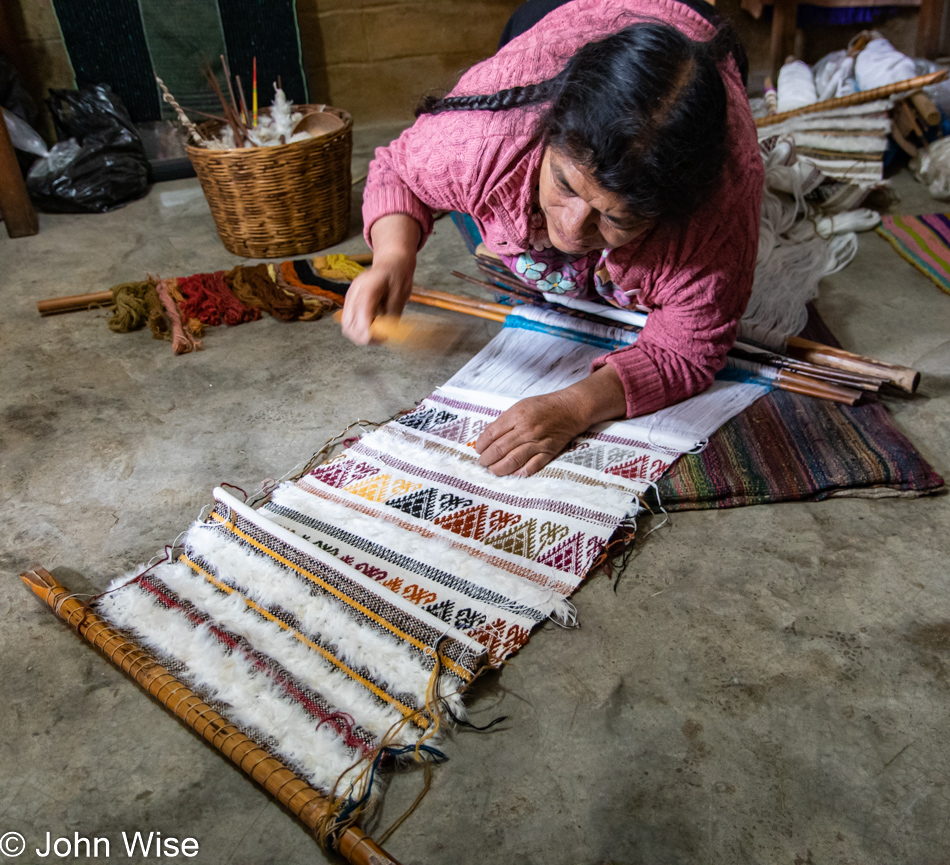
If I’m not mistaken, this woman is about 60, but that doesn’t stop her from working on the cold floor. Though she kneels on a small pad, she has to crawl out to deal with details that require tending to. As my mother-in-law once said to me, “Growing old is not for the weak.”

Gabriela has been a seriously terrific interpreter and guide for us; she has a rapport and natural chemistry not only with the weavers we visit but also with those of us traveling on this introduction to the textile and cultural traditions of Chiapas.
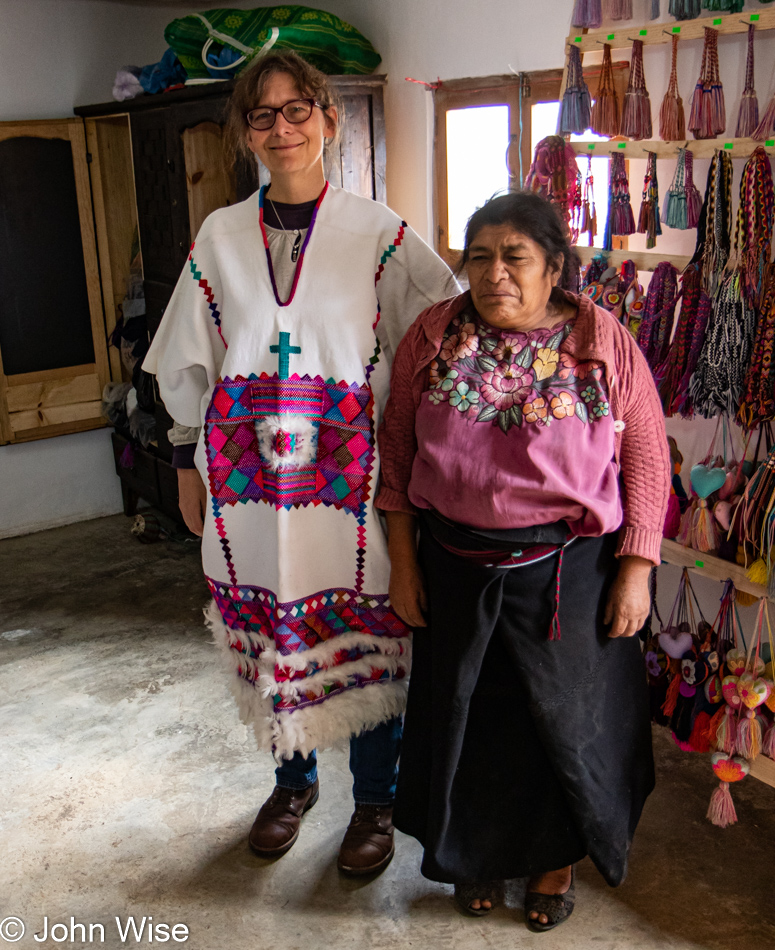
This went sideways quickly. Caroline is trying on a wedding dress that was made by Maruch, which incidentally takes about 11 months to make and sells for about $1800 or $360,000 pesos, which is about what the average person in Mexico earns per year.
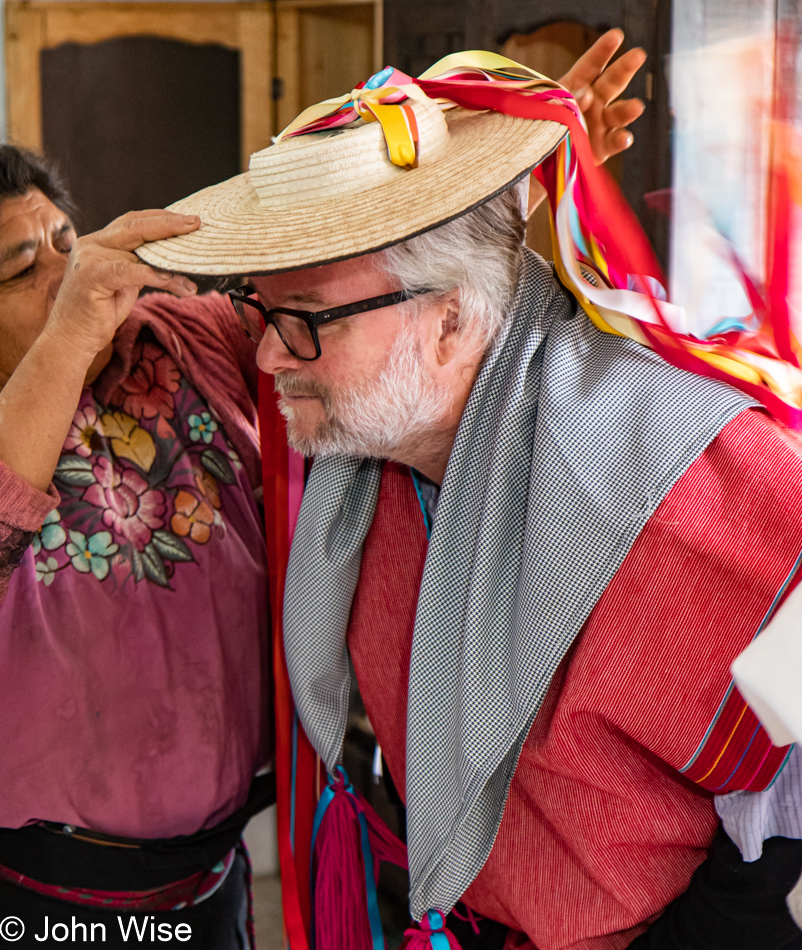
What I meant by going sideways was that Maruch and Lorenza, after dressing Caroline and realizing that I’m her husband, thought I needed the same treatment and started dressing me in the groom’s traditional clothing.

I wish someone had told me to fix my hair on my wedding day and to lose some weight, but as Caroline and I effectively renewed our vows to each other dressed in Zinacantán-style wedding attire in the town of Zinacantán, Chiapas, things couldn’t have been any better. I wonder how many German-American couples are afforded such luxuries?

A close-up of “Caroline’s” wedding dress bedecked with chicken feathers.

That’s Ted Fahy, the other guy on this trip. He’s wearing the clothes of a Mayordomo (Mayor is pronounced My-Ore), who is an official in charge, while Gaby (Gabriela) is wearing the wife’s outfit. Personally, I think these are as elegant as any formal Supreme Court robe worn anywhere else.
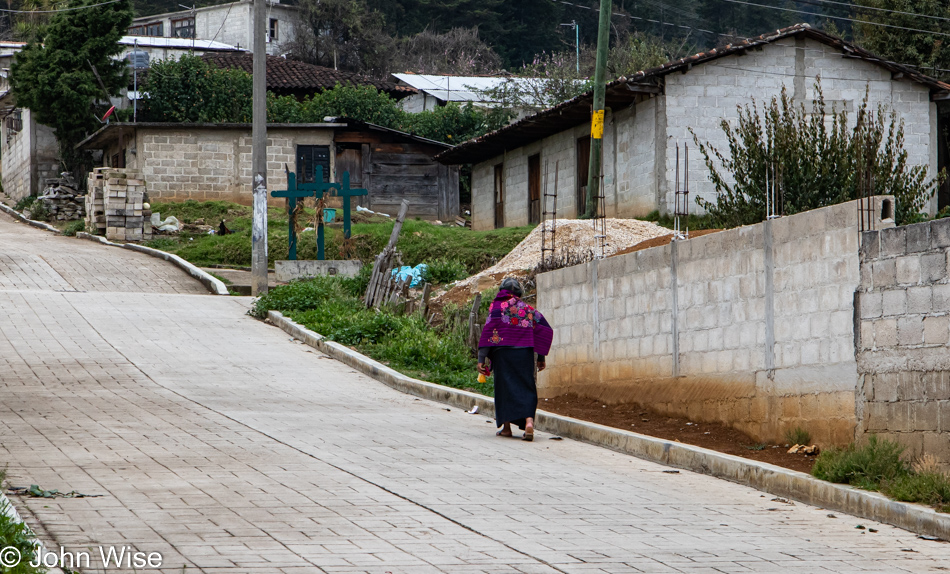
The flower shawls are everywhere there are people of Zinacantán.

Leaving Zinacantán. You can spot some of the greenhouses where flowers are grown, and while there was a saddle with 40 or 50 greenhouses to the right of this photo, it’s not always easy to get the photo you want from a moving vehicle.

We have entered the village of Chamula and are stopping for a few minutes at a cemetery near the edge of the main town.

These are the remains of the church of San Sebastian Chamula. The bells that used to hang in the belfries at the top of this ruin are currently in the church of San Juan Chamula, which I’ll write about below.
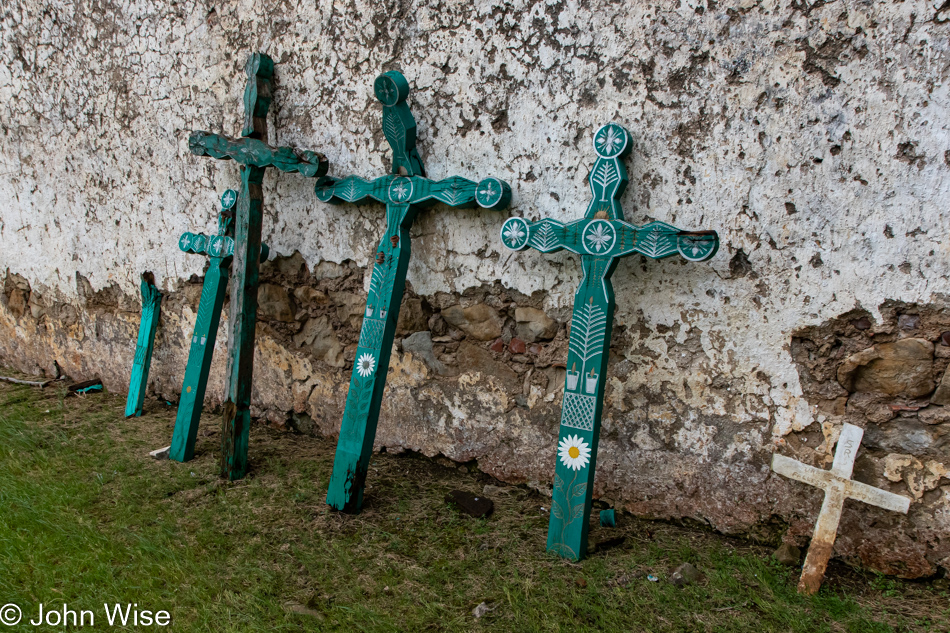
The green crosses are traditional Mayan crosses that allowed the Maya, after colonization, to find similarities with the Catholic belief system, assuaging their conquerors to believe that they were being subservient to Christ while some of their practices could remain alive though they were camouflaged to appease the force that was trying to destroy their traditional culture.
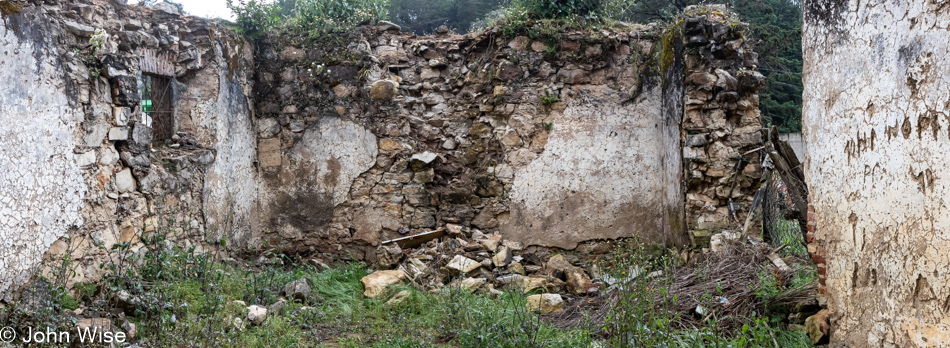
The now open-air side chapel that one day will merge back into the earth.

The tiled altar platform is still nearly perfect without someone having stolen any of the tiles as souvenirs or spray-painted it with satanic symbols, names of girlfriends, or some vulgarity or other. Regarding the altar that once stood here, it too has been brought over to the church of San Juan Chamula.
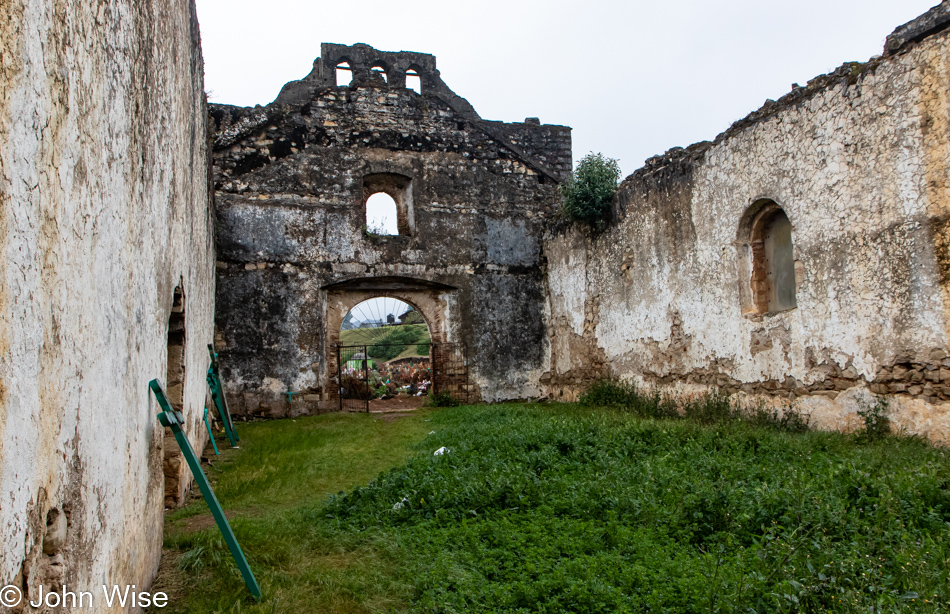
With the same amount of fervor that was used to convert Mayans to Christianity, we should embark on trying to encourage indigenous people to embrace their history when they desire to and not ostracize native people who are suffering due to their heritage. Sadly, to this day, “modern Mexicans” think the people of these villages are backward and to be shunned. Such is the history we’ve been living with and propagating for hundreds of years already.

Look closely at these pine needles, as shortly we’ll see a thick carpet of them.
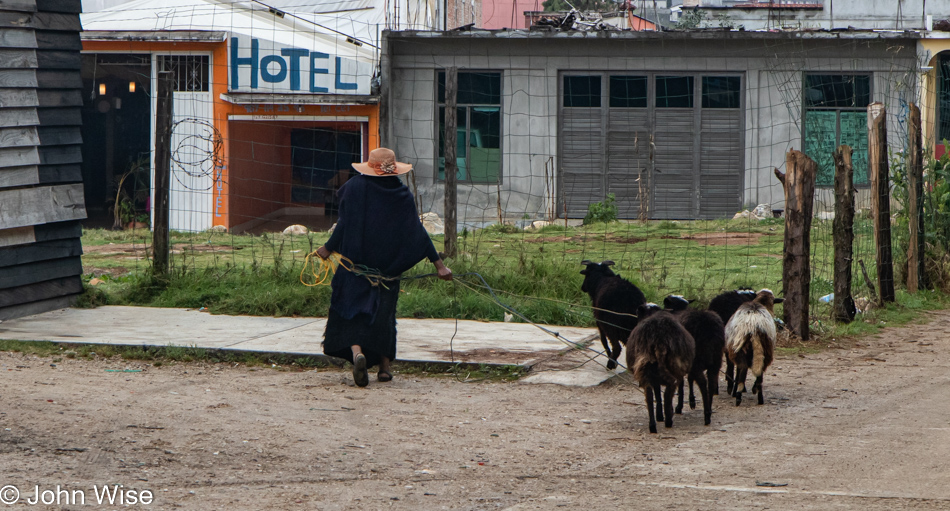
Just a robed man bringing his flock to the sheep hotel. Of note, the people of Chamula hold sheep as sacred as they supply the wool that is used for making their clothes. The sheep are not killed, eaten, or milked; they live a life of luxury, dining on grasses and going out for walks to see the town.

If only I could have found the person to bribe that would allow me to take half a dozen photos inside the Iglesia de San Juan Chamula, I would be considering sharing those right now, but there’s more to that story. Below are some close-up details of the entry to the former Catholic church as I cannot take my camera inside; well, I did, but I kept it in a plastic bag because if you are caught taking photos, things may not end well for you on that day.

How do people worship and offer gratitude when love is deeply known in a familial, land, spiritual, cultural, historical, all-encompassing way? Where one cannot buy love and a shallow, disconnected people more in love with themselves and their horde of things, they will never understand how what they see as impoverishment and primitivism might actually be more sophisticated and full of love than they will ever know.
The church we entered would be difficult to understand for many because a holy place is a sterile void where the soul is only supposed to seek the love of God and Jesus and not a cyclical eternity of ancestors, the productivity of crops, the health of animals, and their personal well-being. Sure, many people will pray when their lives and health are in danger, but typically, only during those precarious moments do they look for god.
It’s a tragedy that god is a commodity for most people around the world. They turn up for a transaction, and with their expectations running high, they demand that a product be delivered, be it salvation, healing, wealth, or help to cope with the grieving of a lost loved one. The saints seem to be failing, but there are no other answers if the void remains unexplored, so we turn to gods.
The impression I’m getting from rural Chiapas here in the Mayan world is that the universe of love requires constant participation of remaining in the cycle of obeisance to traditions. To survive a life where nothing truly ever changes, one must be soundly ignorant or have been born in a wealthy country where they can squander their inheritance and potential as they are vapidly devoted to inanities that will never make them grateful for the little things.
Taking photos in the church is forbidden, and rightfully so, considering Western bias, intolerance, and the demand for conformity. In this sense, we are the primitives.
Though I don’t have a single image, I do feel the need to note what I saw, so I might return on a future day should I stumble into this blog entry again. Walking out of daylight, we enter the temple, dark at first, our eyes adjusting to the surprise of seeing thousands of burning candles from the edges of the nave scattered across the floor. Simultaneously, our senses are hit with the smell of pine needles and burning candles wafting into our noses.
We are in the hive of chants with families lined up behind the temporary shrines of candles set up in a clearing of pine needles otherwise covering the floor. Saints stand along the walls above the hundred or more people kneeling on the floor. There’s really no altar aside from those momentary ones where the devout are looking to synchronize with the universe that they may have desynced from. Occasionally, we catch a glimpse of a dead chicken that was sacrificed here, along with bags of eggs that are being passed over the candles. There are also light and dark drinks that are part of the offering. I described this part above regarding the salt ceremony, but I can’t know for certain that the offerings are linked.
Like the Kachina dances we’ve attended on the Hopi lands, this experience takes us back in history, even if it’s my desire to imprint this with a romanticized notion of a distant past. Our time here is short as there’s still much to do today, but if I had brought a chicken, some eggs, a coke, a bottle of pox, and 150 candles, I might have begun my own prayer routine to ask the universe to bring me back. The church is open 24 hours a day; I’d be most interested in the proceedings between midnight and 3:00 in the morning.
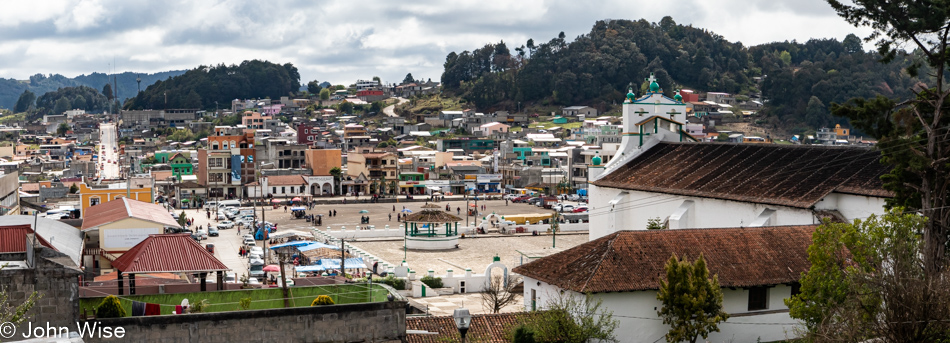
Lunch will be right here in Chamula, up the hill, and in the shadow of this extraordinary house of worship and healing. It’s difficult to reconcile the weight of such an experience down there and jumping into a festive restaurant for a meal.

Lunch was had at Restaurant El Mirador, a lovely place to enjoy a meal. Our group settled around the second-floor dining tables and ordered a variety of dishes for lunch. First up for Caroline, though, was a shot of pox, which she shared with Norma. If I drank, I’d have had the same.
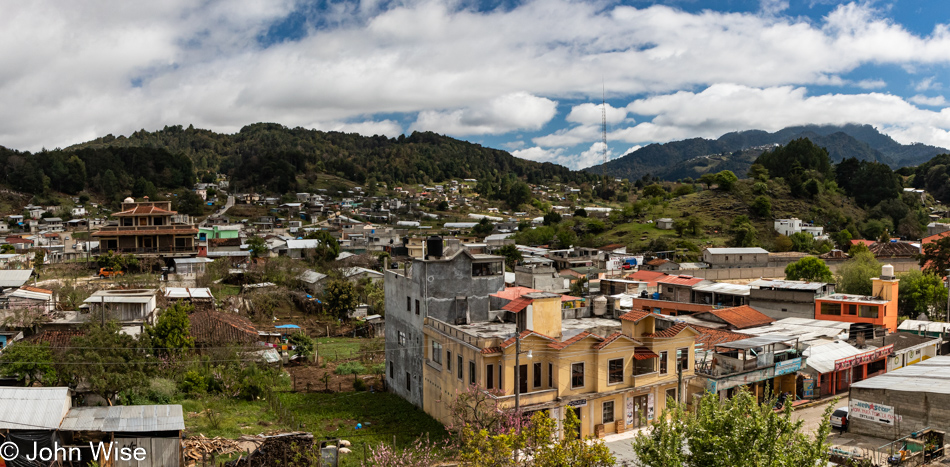
El Mirador not only offers delicious food but also fantastic views of the area. When the weather is nice, one can also dine on the roof. Our next stop is less than 1 kilometer away, but at the same time, it’s yet another world away.

We are at ArTex Centro Cultural Independiente and greeted by the Monkey Men.

While we weren’t able to be on hand for the carnival festivities that were happening a couple of weeks prior to our arrival, our travel planners were able to arrange a private performance for us right here in Chamula.
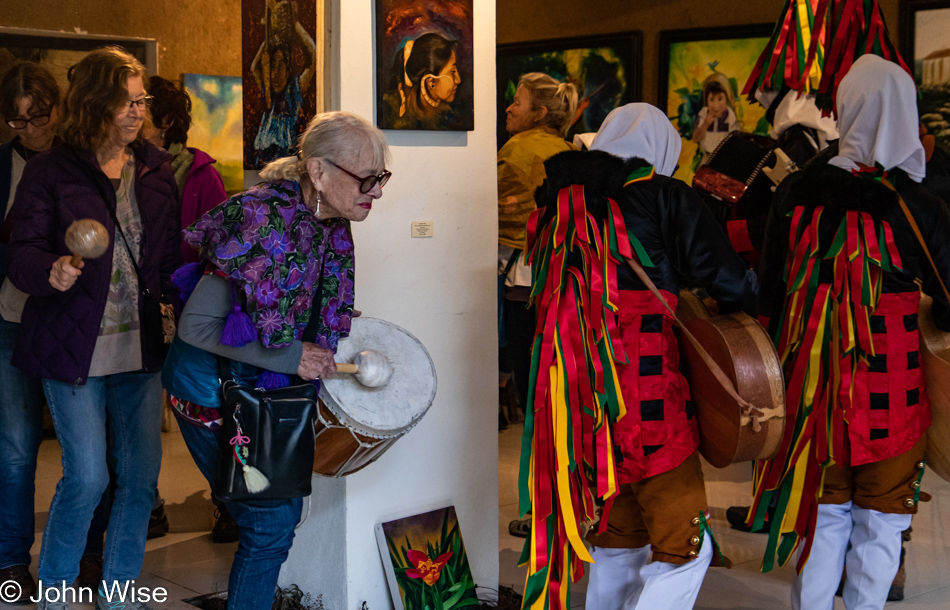
Norma picked up the drum followed by Connie grabbing a maraca before most everyone else joined the Monkey Men as they guided us deeper into our Mayan experience and further away from the routines we are all too often confined within. After a brief introduction to the musicians and Andreas, who founded this artist’s coop, we were invited upstairs to see the premises before a presentation about what’s what.

Andreas works under the name Tex (which is the Mayan version of Andreas and, as I pointed out in a previous post, is pronounced Tesh), while his brother is named Flavio. It is Flavio who is responsible for this; my favorite painting on display here in their workspace.

Even before the start of the presentation, it is obvious that they are using these facilities to teach others in the community how to present their own imaginations via the canvas with painting workshops held right here.
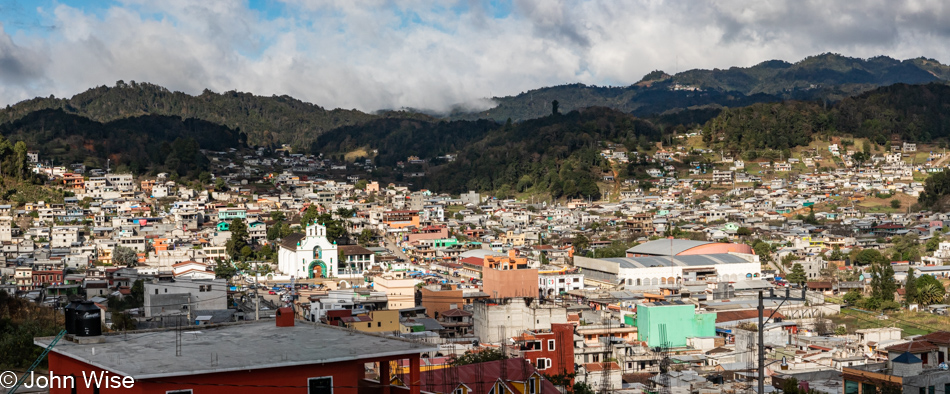
From the top floor of their spacious studio, the view is beautiful and made more so by the sun darting between the clouds to brighten the town below.

Meet Tex, a.k.a. Andreas, and the organizer behind not only the band of Monkey Men but this entire community operation.

Not only are we offered insight into the dress and history of the performers but also what everyone involved is trying to bring to Chamula and the sharing of their rich culture.

That little figure at the bottom center of this painting is finding its way into me, but still, I’m reluctant to inquire about the price of one of Tex’s pieces. We are in Mexico for experiences, textiles, and flavors, not art.
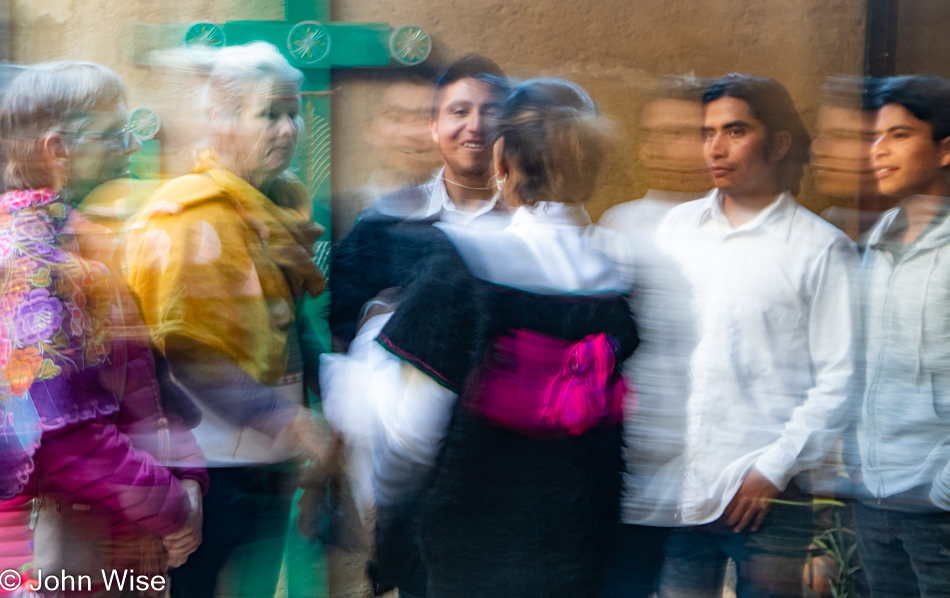
Gabriela had seen one of my slow shutter photos where I captured ghost images of cows crossing the road (chickens know to stay on their own side in Mexico); well, I didn’t much like that ghost cow photo, so instead, I’m sharing this one featuring the ghosts of the Monkey Men for her.

The rock stars of Chamula.

The mural outside of the ArTex Centro Cultural Independiente studio is a work in progress, just as the sharing of culture from the Chiapas Highlands is. Those monkeys on the girl’s arm, we bought one so we, too, might carry an artifact from Chamula with us on our future travels.
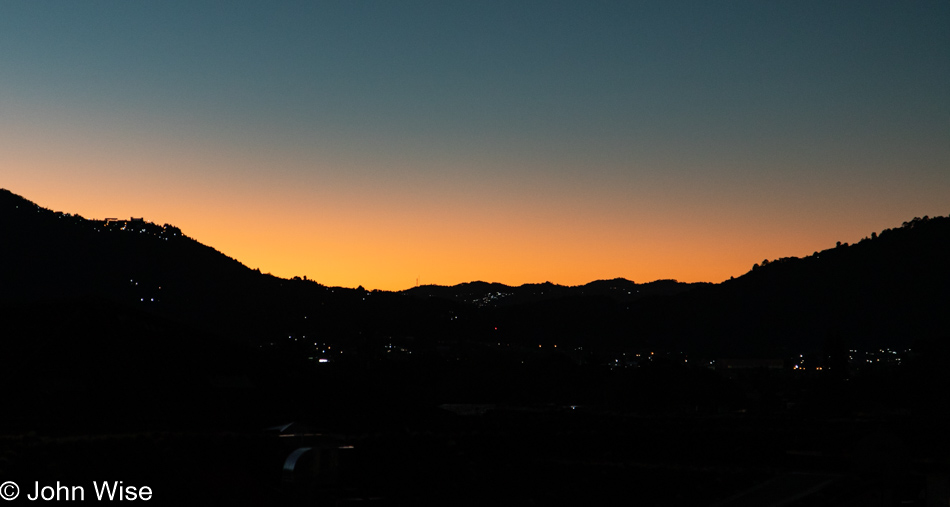
Sitting on a rooftop terrace at the Kinoki Independent Cultural Forum and enjoying hot tea was how we brought on the night as sunset came and went. This place that also shows films and serves food is one of Gaby’s favorite stops in San Cristóbal, hence why we are here. No matter what I’m able to bring to this blog, I’ll likely never be able to convey to Norma and Gabriela just where they brought Caroline and me. Gratitude is too simple an idea to express what happens when experience moves beyond the surface and travels within the depth of existence. We’ve come far and are still going further.